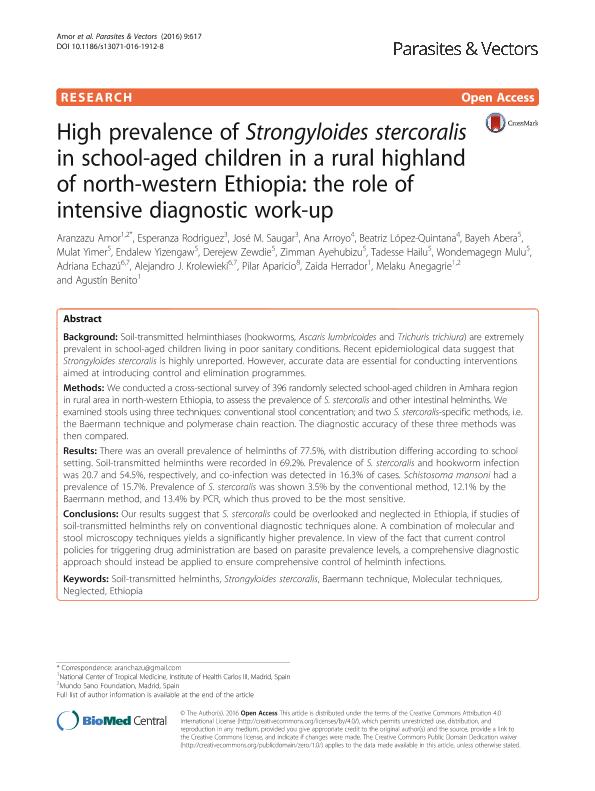Mostrar el registro sencillo del ítem
dc.contributor.author
Amor, Aranzazu
dc.contributor.author
Rodriguez, Esperanza
dc.contributor.author
Saugar, José M.
dc.contributor.author
Arroyo, Ana
dc.contributor.author
López-Quintana, Beatriz
dc.contributor.author
Abera, Bayeh
dc.contributor.author
Yimer, Mulat
dc.contributor.author
Yizengaw, Endalew
dc.contributor.author
Zewdie, Derejew
dc.contributor.author
Ayehubizu, Zimman
dc.contributor.author
Hailu, Tadesse
dc.contributor.author
Mulu, Wondemagegn
dc.contributor.author
Echazú, Adriana

dc.contributor.author
Krolewieki, Alejandro J.
dc.contributor.author
Aparicio, Pilar
dc.contributor.author
Herrador, Zaida
dc.contributor.author
Anegagrie, Melaku
dc.contributor.author
Benito, Agustín
dc.date.available
2018-02-28T20:41:36Z
dc.date.issued
2016-01
dc.identifier.citation
Amor, Aranzazu; Rodriguez, Esperanza; Saugar, José M.; Arroyo, Ana; López-Quintana, Beatriz; et al.; High prevalence of Strongyloides stercoralis in school-aged children in a rural highland of north-western Ethiopia: the role of intensive diagnostic work-up; BioMed Central; Parasites and Vectors; 9; 1; 1-2016; 1-9
dc.identifier.issn
1756-3305
dc.identifier.uri
http://hdl.handle.net/11336/37498
dc.description.abstract
Background: Soil-transmitted helminthiases (hookworms, Ascaris lumbricoides and Trichuris trichiura) are extremely prevalent in school-aged children living in poor sanitary conditions. Recent epidemiological data suggest that Strongyloides stercoralis is highly unreported. However, accurate data are essential for conducting interventions aimed at introducing control and elimination programmes. Methods: We conducted a cross-sectional survey of 396 randomly selected school-aged children in Amhara region in rural area in north-western Ethiopia, to assess the prevalence of S. stercoralis and other intestinal helminths. We examined stools using three techniques: conventional stool concentration; and two S. stercoralis-specific methods, i.e. the Baermann technique and polymerase chain reaction. The diagnostic accuracy of these three methods was then compared. Results: There was an overall prevalence of helminths of 77.5%, with distribution differing according to school setting. Soil-transmitted helminths were recorded in 69.2%. Prevalence of S. stercoralis and hookworm infection was 20.7 and 54.5%, respectively, and co-infection was detected in 16.3% of cases. Schistosoma mansoni had a prevalence of 15.7%. Prevalence of S. stercoralis was shown 3.5% by the conventional method, 12.1% by the Baermann method, and 13.4% by PCR, which thus proved to be the most sensitive. Conclusions: Our results suggest that S. stercoralis could be overlooked and neglected in Ethiopia, if studies of soil-transmitted helminths rely on conventional diagnostic techniques alone. A combination of molecular and stool microscopy techniques yields a significantly higher prevalence. In view of the fact that current control policies for triggering drug administration are based on parasite prevalence levels, a comprehensive diagnostic approach should instead be applied to ensure comprehensive control of helminth infections.
dc.format
application/pdf
dc.language.iso
eng
dc.publisher
BioMed Central

dc.rights
info:eu-repo/semantics/openAccess
dc.rights.uri
https://creativecommons.org/licenses/by-nc-sa/2.5/ar/
dc.subject
Baermann Technique
dc.subject
Ethiopia
dc.subject
Molecular Techniques
dc.subject
Neglected
dc.subject
Soil-Transmitted Helminths
dc.subject
Strongyloides Stercoralis
dc.subject.classification
Salud Ocupacional

dc.subject.classification
Ciencias de la Salud

dc.subject.classification
CIENCIAS MÉDICAS Y DE LA SALUD

dc.title
High prevalence of Strongyloides stercoralis in school-aged children in a rural highland of north-western Ethiopia: the role of intensive diagnostic work-up
dc.type
info:eu-repo/semantics/article
dc.type
info:ar-repo/semantics/artículo
dc.type
info:eu-repo/semantics/publishedVersion
dc.date.updated
2017-09-01T18:03:56Z
dc.journal.volume
9
dc.journal.number
1
dc.journal.pagination
1-9
dc.journal.pais
Reino Unido

dc.journal.ciudad
Londres
dc.description.fil
Fil: Amor, Aranzazu. Universidad Carlos III de Madrid. Instituto de Salud; España
dc.description.fil
Fil: Rodriguez, Esperanza. Universidad Carlos III de Madrid. Instituto de Salud; España
dc.description.fil
Fil: Saugar, José M.. Universidad Carlos III de Madrid. Instituto de Salud; España
dc.description.fil
Fil: Arroyo, Ana. Hospital Universitario la Paz - Carlos III; España
dc.description.fil
Fil: López-Quintana, Beatriz. Hospital Universitario la Paz - Carlos III; España
dc.description.fil
Fil: Abera, Bayeh. Bahir Dar University; Etiopía
dc.description.fil
Fil: Yimer, Mulat. Bahir Dar University; Etiopía
dc.description.fil
Fil: Yizengaw, Endalew. Bahir Dar University; Etiopía
dc.description.fil
Fil: Zewdie, Derejew. Bahir Dar University; Etiopía
dc.description.fil
Fil: Ayehubizu, Zimman. Bahir Dar University; Etiopía
dc.description.fil
Fil: Hailu, Tadesse. Bahir Dar University; Etiopía
dc.description.fil
Fil: Mulu, Wondemagegn. Bahir Dar University; Etiopía
dc.description.fil
Fil: Echazú, Adriana. Universidad Nacional de Salta. Sede Regional Orán. Instituto de Investigación de Enfermedades Tropicales; Argentina. Consejo Nacional de Investigaciones Científicas y Técnicas; Argentina
dc.description.fil
Fil: Krolewieki, Alejandro J.. Universidad Nacional de Salta. Sede Regional Orán. Instituto de Investigación de Enfermedades Tropicales; Argentina. Consejo Nacional de Investigaciones Científicas y Técnicas; Argentina
dc.description.fil
Fil: Aparicio, Pilar. Universidad Carlos III de Madrid. Instituto de Salud; España
dc.description.fil
Fil: Herrador, Zaida. Universidad Carlos III de Madrid. Instituto de Salud; España
dc.description.fil
Fil: Anegagrie, Melaku. Universidad Carlos III de Madrid. Instituto de Salud; España
dc.description.fil
Fil: Benito, Agustín. Universidad Carlos III de Madrid. Instituto de Salud; España
dc.journal.title
Parasites and Vectors

dc.relation.alternativeid
info:eu-repo/semantics/altIdentifier/doi/http://dx.doi.org/10.1186/s13071-016-1912-8
dc.relation.alternativeid
info:eu-repo/semantics/altIdentifier/url/https://parasitesandvectors.biomedcentral.com/articles/10.1186/s13071-016-1912-8
Archivos asociados
